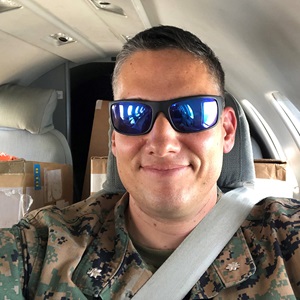By Marcus, as told to Morgan Frazer

It’s a memory burnt into my mind: Cleveland, Ohio, 1995, walking into a recruiter’s office after my 17th birthday to enlist. Little did I know I would walk out of that office and into a career where the next 25 years of my life were spent serving in the United States Marine Corps.
I started out in the infantry and later became an air traffic control (ATC) officer. While in training, I witnessed the biggest terrorist attack to hit U.S. soil — 9/11. It was a moment frozen in time for us as we learned what was happening from hearsay and local news reports across the airwaves. At first, everyone in my class thought it was an accident. I remember naively thinking, “Some air traffic controller is in big trouble.” But then the second tower was hit, and we immediately knew America was under attack. An enemy had put a target on the place I loved — my country — and war was imminent.
Fast forward a few months and I was deployed in support of Operation Enduring Freedom as an air traffic controller with Marine Air Control Squadron (MACS) 4 and led ATC operations to support fixed-wing aircraft landing in austere environments.
Twenty-five years of supporting the defense of this nation flew by and what started as an adventure turned into a career I couldn’t live without.
Continuing the mission and improving the warfighter’s effectiveness is exactly what we do here, and it has made my transition into the civilian sector easier and more purposeful.
— Marcus
Defending our Nation
When I made the decision to hang up my uniform and leave the Marines, I began looking for opportunities. Northrop Grumman grabbed my attention and what stuck out to me was the easily understood and relatable company values that directly aligned to mine. It was also a chance to be program manager of Northrop Grumman’s Command and Control Personal Computer (C2PC).
Let me run you through a scenario:
A call comes through to the command operations center from a forward observer across enemy lines. I pick up the call and immediately grab my pencil to receive enemy grid coordinates, lean over the map taped across the table and plot them. I pick up the phone to relay the coordinates to the Marine aviation combat element, the aviation arm of the Marine Air-Ground Task Force (MAGTF), and we compare the plots for accuracy before relaying the information to the units operating in the battlespace.
This process only takes a few minutes, but in today’s age of data-driven warfare, mere moments seem like a lifetime when warfighters are operating in contested environments. That’s where C2PC comes into play. This capability was developed by Northrop Grumman for the Marine Corps to maintain situational awareness and deconflict the battlespace in near real-time rather than the outdated pencil-and-stencil method. I used C2PC throughout my military career while I was deployed for training and combat, and now I lead the program here at Northrop Grumman.
Living the Mission
My experience as an end-user helped me tremendously as I transitioned into my civilian role. I have a deeper understanding of the capabilities and can use that knowledge to team up with our engineers to articulate improvements and deliver a better end-product to those who are boots on the ground, where I used to be.
Continuing the mission and improving the warfighter’s effectiveness is exactly what we do here, and it has made my transition into the civilian sector easier and more purposeful. I am proud to work for a company that develops and delivers proven, reliable technology that keeps our warfighters safe and helps to ensure our freedom.